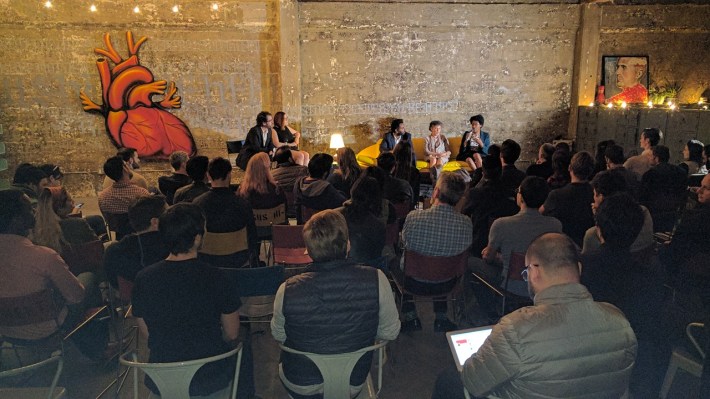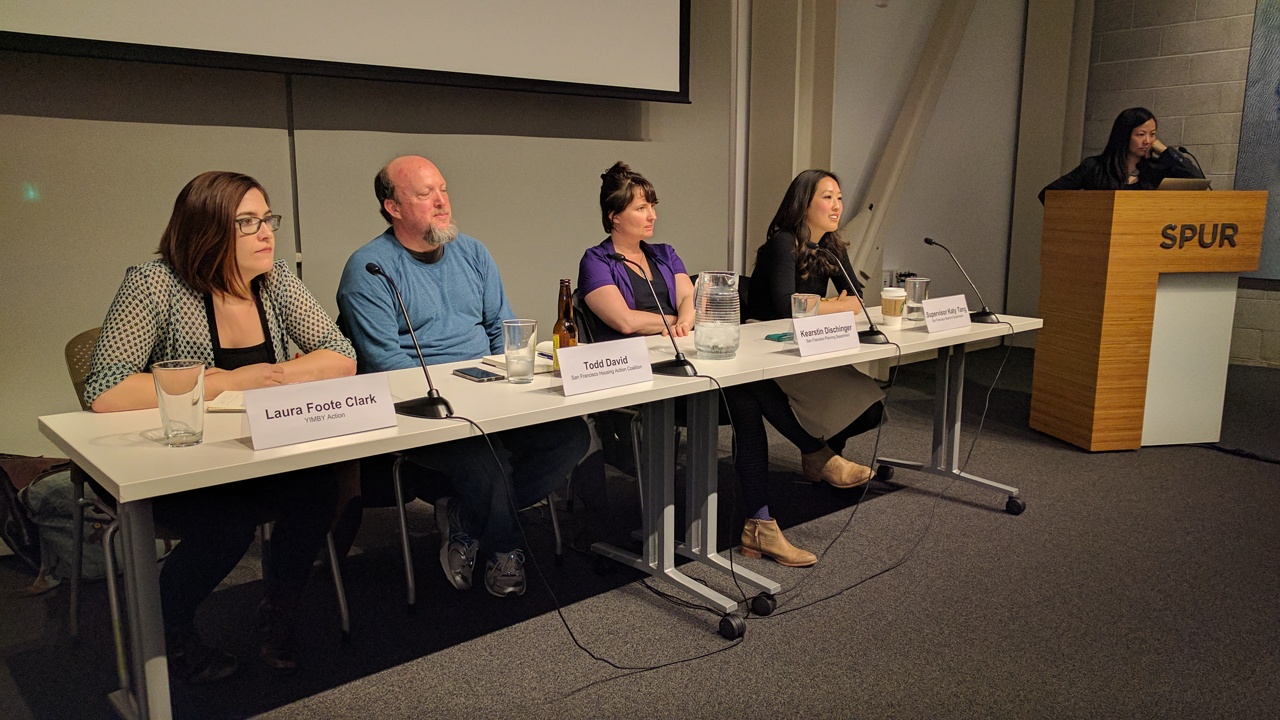"Our planning process is broken," said San Francisco Planning Commissioner and SPUR SF director Christine Johnson, at a panel discussion last night in the Mission held by the YIMBY party of San Francisco. YIMBY's mission, for those who may not be familiar with the group, is to advocate for affordable and market-rate housing, with the goal of bringing down cost in the Bay Area.
The first question for the three-member panel, poised by YIMBY's Brian Hanlon, was why would anyone want to be a planning commissioner in the first place and "...get involved with yelling and hectoring and claims you are destroying your community?"
"I love cities. I’ve always loved cities," answered Adhi Nagraj, a commissioner from Oakland. Nagraj, originally from Boston, started his career in education. He recalled having a student who was not well behaved. One day, Nagraj saw the student's neighborhood and began to understand the impact that the built environment has on people's psyches. "I went into his neighborhood on the bus and saw the horrible, crappy area he grew up in and it got to me wanting to help poverty...it got me thinking about what I can do about rejuvenating urban areas."
This led him to change careers, and he now works for Bridge Housing, a developer of affordable housing. As a developer, he said, he's involved in the minutia of building and finance. Working on the planning commission helps him to "...take a step back and look at the larger issues of where do we build commercial, where to build residential."
Johnson, meanwhile, was in public finance but, after a chance encounter, ended up working with Mayor's Newsom's administration on environmental issues in Hunter's Point. "My very first meting there was an issue with serpentine rock in Hunter's Point--if you drill into it, asbestos comes out. So it was a major environmental justice issue for the area," she recalled. That turned into "hours long hearings about how we were killing black people, and I was like, what have I gotten myself into! But after I got over the shock of that, I realized I wanted to learn more."
For Denise Pinkston of the Berkeley Planning Commission, her path into it was based on an underlying belief in democracy, she said. "And if you believe in democracy, that your role is to get engaged, then you get your clipboard, put on your tennis shoes, and get out there," she said. But she's also concerned about her adult children, who can no longer afford to live in the Bay Area. "My kids would like to come back to the community they grew up in," she said.
Hanlon then asked about advocacy, and how it influences their decisions on the planning commissions on which they serve. "What is the utility of getting people out there to testify for housing?" he asked.
"It makes a difference, but it depends on the commissioners. They value the people who take the time to show up on a Thursday in the hearing room who wait for hours for the three minutes," said Johnson. But she added that she's equally, and perhaps more concerned, with the people who can't show up, so she makes sure to read emails and take phone calls "...to get the context from people who aren’t at the hearings every week."
Nagraj agreed. "It’s a factor. It’s helpful. It's easier for my fellow planning commissioners to approve a project," he said.
That said, the commissioners all seemed to concede it is the process itself--or at least how it's structured--that is at the source of the affordability crisis. "In San Francisco, we have discretionary permits; everything is discretionary. That has led to a planning code, and to some extent a building code that is vague," said Johnson. It leads to so many discussions, compromises, asks, and changes that projects end up sitting stagnant for years as they wind through the hearing process. "It’s the death of a thousand cuts to get a plan approved," said Pinkston. "You go to the neighborhood and they want more parking, so you nip and you tuck, and then you shave things off and build down...by the final hearing, the project is marginal."
The commissioners explained that every time a compromise is struck, builders have to go back to lenders and financiers and renegotiate. Pretty soon, the project barely pencils out. Often times, it kills them all together. "Developers give up and withdraw...that constant renegotiation of the terms of engagement, you guarantee you will have a housing crisis in-perpetuity, because supply can never respond to demand cues," said Pinkston.
That's why Governor Brown proposed "by-right" legislation in 2016, which would have basically allowed developers to adhere to a statewide criteria for building approval that would preempt local reviews. The legislation failed, and Pinkston said that was a mistake. "We have a problem with the delivery of housing projects in California that is causing massive dislocation," said Pinkston. "There are moms who get on a bus at five in the morning and commute two hours to work at a minimum wage job, and people are okay with that. I am not okay with that."
YIMBY's Laura Foote Clark agreed, and recalled finding a flyer at her home from neighbors opposed to someone adding a second housing unit into a single-family home. "My neighbors said it would be the end of days," recalled Clark. She tried to organize Millennials to fight for allowing that extra home to be built. "How can we amplify those voices," she asked.
The panelists suggested that government needs to get better at hearing the voices of Millennials, by being more responsive to social media. And, in turn, Millennials need to learn to illustrate their housing woes with compelling stories of those who are impacted, "...paying $800 to sleep on a sofa in Temescal," said Nagraj.
Pinkston said they do what they can to balance the need for more housing against opponents of new development. She said, for one, she's very hopeful about new laws allowing Accessory Dwelling Units throughout the state. "I’m a fan of second units, letting them move into buildings that are already there. Let's remodel accessory units into every building in California," she said.
From Streetsblog's perspective, however, there's a little too much nipping around the edges. It's supposed to be a housing "crisis" after all. Accessory units are nice, if we want a city where some people have big houses, and the rest live in their garages. Much of the planning code needs to be tossed out. "Keep the seismic codes," said Pinkston, and get rid of everything else. Certainly, it's ridiculous that in San Francisco, even areas next to transit nodes--think of West Portal--are zoned for single family houses, single use, and one or two stories only. People in the Bay Area are quick to talk about inclusive values in theory, but resist whenever codes need to be altered to actually include people. That has to change.
The result: "Projects aren’t getting built; there are 60,000 with entitlements with only 6,000 getting built," said Johnston. Pinkston added that they have to build at least 100,000 units to start making the Bay Area affordable again for the middle class. For now, the commissioners said they just try and do the best they can to get projects done.
"I try to speak for those people who aren’t there, the people of the future," said Johnson.






